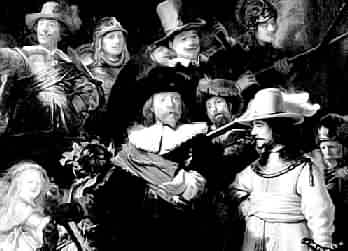
MARCH OF THE TITANS - A HISTORY OF THE WHITE RACE
CHAPTER 30 : THE LOW COUNTRIES: THE NETHERLANDS, BELGIUM AND LUXEMBOURG
The Low Countries - the Netherlands, Belgium and Luxembourg have, despite their small size, played a significant role in European and world history, the latter mainly through their colonial possessions and its after effect - the immigration of the former colonies' inhabitants into Europe.
In 1989, the World Bank report on Africa drew an astonishing comparison: it said that the entire Gross Domestic Product (GDP) of all of sub-Saharan Black Africa (which excluded the oil rich Arab states in the north and the then White ruled country of South Africa) was, at 1989 currency levels, some $116 million, or GBP411 million - a figure, the bank report went on to point out, was equivalent to the GDP of Belgium alone. (Sunday Times, 26 November 1989).
The story of these remarkable Low Countries is therefore of interest in comparative values, and, like many European countries, does much to destroy the "environmental" theory of the advancement of nations.
ANCIENT PERIOD
The area now known as the Netherlands, Belgium and Luxembourg was, like much of ancient Europe, first occupied by Old Europeans and Proto Nordics who left basic Neolithic settlements. The region appears to have been fairly thinly populated, probably due to the low lying coastal nature of the land, which did not make it the easiest land upon which to settle.
The north eastern part of Europe was however also occupied by the great wave of Indo-European invaders of the second millennium BC, and with these Celtic peoples, the basis was laid for the racial make-up of the peoples of that region, with only minor variations.
ROMAN OCCUPATION - CAESAR SUBJUGATES BELGAE
Roman armies, led by Julius Caesar personally, overran the Celts of North Western Europe during the 1st Century BC, subjugating all the tribes in the area, including one referred to in Roman records as the Belgae (from where the word Belgium would originate).
The Roman invasion did not substantially alter the racial make-up of the population. Most of the occupying Romans were of the same basic sub-racial stock as the Celts, although on average they were a bit shorter and a bit darker as a result of the larger number of Old Europeans who had been absorbed into the original Latini Indo-European tribe in Italy.
Under Roman rule, relative peace and prosperity prevailed for more than 250 years, and the land was slowly built up, mainly with farming.
GERMANIC INVASION - 300 AD
The north western parts of Europe then fell prey to the new wave of Germanic invaders around 300 AD, an invasion which occurred in many Western European countries and which ultimately would see Germanics sacking Rome.
One of these tribes which maintained its identity was the Frisians, who later gave their name to a northern province of the Netherlands. Saxons invaded from the East, while the Franks invaded from the West and South.
The influx of these Germanic tribes further strengthened the Nordic racial sub-element within the population make-up.
THE NETHERLANDS
The rise of the Frankish Empire after the collapse of the Roman Empire saw Christianity being introduced - often by the sword - to the Germanic and Celtic tribes of north eastern Europe, and in this way the area fell under the sway of the rule established by Charlemagne, King of the Franks.
After Charlemagne died his empire was divided up amongst his sons - the Netherlands became part of the middle kingdom, Lotharingia (Lorraine) and still later, in 925, part of the Holy Roman Empire.
THE VIKINGS
Frankish rule was however severely disrupted by yet another wave of invading Nordic tribes - the Viking invasions of the 8th Century saw the settlements in the Netherlands (and all along the Western European coastline) invaded and sacked by bands of Viking raiders in their longboats.
The Viking invaders left two major legacies in the Netherlands. For the first time walled and fortified cities were built, and secondly, the fairly wanton rape and pillaging by groups of Vikings added not inconsiderably to the Nordic gene pool in the area.
Finally, some less violent bands of Vikings also settled in the area, with the biggest and most formal group settling in a nearby region of France to become the Normans.
CENTER OF TRADE
The Netherlands then settled down to three centuries of relative peace, during which time the region became an important trading center, situated as it is at the crossroads of Europe.
This status as a trade nation has persisted to the present day, with the port of Rotterdam still being the single largest port in the world, handling more cargo than any other single harbor.
HABSBURG RULE
The rise of the German House of Habsburg in the 16th Century, saw virtually all the lands of the Netherlands fall under the control of the Germans, who by this stage held the crown of Spain. The Habsburg Emperor, Charles V, granted control of Spain and the Netherlands to his son, Philip II, in 1555.
FIRST DUTCH WAR OF INDEPENDENCE
Despotic rule by the Spanish King Philip II led to the first Dutch War of Independence. The conflict raged on in fits and starts for eighty years, combining with the Protestant Reformation which started at the same time - soon the war with Spain became entangled with the general Catholic/Protestant conflagration which consumed Europe.
The implementation of the Inquisition (which in the Netherlands became an attempt to suppress Protestantism) provoked further public resistance and in 1566, anti-Catholic riots broke out in many Dutch cities which saw Catholic Churches being trashed.
Philip sent Spanish troops to avenge this outrage against the Church. The harsh rule imposed by these Spanish troops resulted in further rebellion and by 1568, a state of open war existed between the Dutch and the Spanish.

Detail from Rembrandt, The Company of Captain Frans Banning Cocq, better known as the Night Watch, 1642. It shows a good spread of Dutch racial types. Rijskmuseum, Amsterdam.
PRINCE WILLIAM OF ORANGE
A leading Dutch noble, Prince William of the House of Orange, (also known as the Prince of Orange) led the revolt and soon won control of most of the Northern part of the Netherlands. In 1579, the Union of Utrecht, an alliance of all northern and some southern territories, was formed with William being installed as King William I. The provinces that joined the union would become the Netherlands - those that did not would become Belgium.
In 1581, the Union of Utrecht proclaimed independence from Spain, provoking yet another furious invasion from the latter country. The war went poorly at first for the Dutch, who suffered many reverses including the murder of William in 1584. By 1585, the Spanish had reconquered practically all the south, including Antwerp.
The intervention of England however turned the tide against the Spanish. The destruction of the Spanish Armada in 1588, after it had failed to pick up a large Spanish land based army (due to Dutch rebels closing the ports under their control) dramatically weakened Spain's ability to wage war abroad. By 1600, the last Spanish troops were driven out of the Netherlands.
In 1648, the Dutch and Spanish signed the Treaty of Munster, in terms of which the Netherlands became independent for the first time since the original Roman occupation.
EXPLORATION AND A WORLD EMPIRE - NEW YORK FOUNDED
Lying so close to the sea, the Dutch were masters of the waves, and their navy, both civilian and military, soon rivaled that of any other major European power. Closely following the explorations undertaken by the original Portuguese, the Dutch sent exploration and trading missions to the new world. By 1600, the first successful trading mission had been established in Indonesia in South East Asia, and the beginning was made to the creation of a massive Dutch trading and colonial empire.
Many hundreds of thousands of Dutch people left the country at the height of its colonial era: a significant amount went to America (where they founded the city of New Amsterdam. After it was lost to the English, the city was renamed New York) and a significantly large number went to South Africa, where they formed the basis for what later became known as the Boers.
The full extent of the Dutch voyages can be seen in the names given to geographic points all over the world: Spitsbergen to Cape Horn, Staten Island in Tasmania and many others.
In addition to this, the Dutch founded two companies, the Dutch East India Company and the Dutch West India Company, both of whom were empowered by the Dutch government to establish bases in Africa, America and Asia. Both companies were also given the right to wage war.
WARS WITH ENGLAND - DUTCH SAIL UP THE THAMES
The sudden expansion of Dutch power following independence from Spain almost immediately caused conflict with the other European power then expanding its commercial and colonial interests in the new world - England.
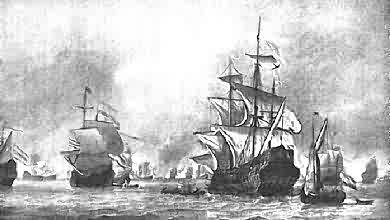
The Dutch war with the English: the Dutch fleet in the Thames River. The Dutch navy - a fleet born of a sea going nation - seriously challenged the might of the English fleet twice. In 1666, a massive engagement took place near the mouth of the Thames River, which saw 6,000 Englishmen killed and 23 vessels lost, for 800 Dutch dead. The next year the Dutch, under their great Admiral De Ruyter, actually sailed up the Thames as far as the town of Gravesend, destroying and burning English shipping as he went.
Two Anglo-Dutch Wars were waged during the 1650s and 1660s - during which a cheeky Dutch fleet actually sailed up the Thames River to raid England. Other wars, costly in lives and money, followed against England and France. The end result of these wars was that the Dutch lost several valuable overseas possessions to the English and were defeated on land by the French.
INDEPENDENCE LOST - NAPOLEON'S BROTHER RULES
In the late 18th Century, the unity of the Netherlands was disputed by a conflict between those wanting greater democratic reforms (inspired by events in North America and France) and those wanting to keep the old order - the groups becoming known as the Patriot Party and the House of Orange respectively.
The Orangists were supported by a Prussian invasion in 1787, but by 1795, a combination of French revolutionary troops and a council of Dutch republicans had invaded and had established a new government, known as the Batavian republic.
The Batavian Republic existed until 1806, whereafter Napoleon occupied the country and put one of his brothers onto the vacant Dutch throne, first transforming the country into the kingdom of Holland and then in 1810 incorporating the country into the greater French Empire. While the Dutch were under French rule, the British seized Dutch colonial possessions, including the important Cape of Good Hope in South Africa.
INDEPENDENCE RESTORED
When Napoleon was finally beaten, Dutch independence was restored by the Congress of Vienna in 1815, with the territory making up the new Dutch kingdom then included that known as Belgium.
The Belgians were however a divided nation: half spoke French and half spoke a Dutch dialect, Flemish. By 1830, the Belgians had rebelled and had claimed their independence. A Dutch invasion was successful but international pressure forced both sides to accept Belgian independence in 1839.
LIBERALISM AND REFUGE - DUTCH TOLERANCE
The Netherlands had long been known for its tolerant attitude towards dissenters in Europe. Many great thinkers of the reformation and renaissance, when pursued by angry Catholics or Protestants, found refuge in the Netherlands - and many Spanish Jews, fleeing the Spanish Inquisition, were also given refuge in the small country.
This tradition continued through the 19th Century - social reform and democratization in the Netherlands set the pace for much of Europe, another Dutch tradition which has persisted to the present day.
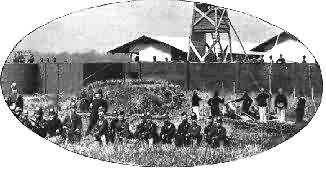
Dutch soldiers and two mortar squads photographed in position in one of the Dutch forts on the Far East island of Bali, early 1900s. The Dutch colonial empire was far flung - on Bali wars with the Nonwhite natives lasted more than thirty years. The Netherlands has however paid a price for the its colonial empire - at the end of the 20th Century, the majority of Nonwhite immigrants into that country have been from former colonial possessions.
WORLD WAR ONE
Remaining neutral during the First World War was a difficult task for the Netherlands. Although the land itself was not invaded, economically it suffered hardship as a result of an English blockade of Europe aimed at the Germans.
THE AFSLUITDYK
Despite the deprivations caused by the First World War, the Dutch recovered well, and continued to expand directly afterwards. By the second decade of the 20th Century the Dutch had become masters at containing the sea. Huge areas of land had even been reclaimed from the sea, leading to almost a third of the country actually being below sea level, cut off behind massive dikes for which the country has, like windmills, become famous.
Much of the land that lies below sea level is still kept dry by continuous mechanical pumping. The largest of these projects was the stunning Afsluitdyk - or "Closing Off Dike" which was finished in 1932. Cutting off a huge stretch of the North Sea, the Afsluitdyk created an inland fresh water sea known as the Issjelmeer, large parts of which were then reclaimed, an ongoing process which has lasted more than 60 years.
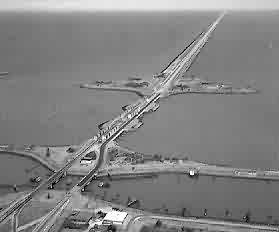
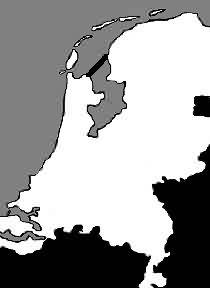
Nowhere better is the White Dutch technological genius better illustrated than with the technological wonder of the Aflsuitdyk - or 'closing off dike'. The incredible 32,5 kilometer long dike built straight across the North Sea in just five years from 1927 to 1932, closed off an entire section of that sea and allowed massive land reclamation. Alongside, a map of the Netherlands showing the position of the Afsluitdyk (thick line).
In many ways the Afsluitdyk represents one of the greatest technological achievements of the tiny Dutch nation. It is a stunning engineering feat which has not been duplicated anywhere in the world, even by much larger powers.
WORLD WAR TWO
Although officially neutral once again during the Second World War, the Netherlands was invaded by Germany as part of that country's campaign against France, and fell under German control from 1940 to 1945.
The greatest single blow to the Netherlands occurred when the German airforce bombed the city of Rotterdam in a show of might - after that the Dutch had little choice but to surrender or face more of the same. Along with the rest of Europe, the Netherlands suffered great hardship during the war, and took several years to recover.
Also in common with many European colonial powers, the period directly after the Second World War saw colonial rebellions and independence.
The Netherlands lost a war against nationalists in Indonesia, which gained its independence in 1949. Netherlands New Guinea gained its independence in 1962 and Surinam in 1975. The Netherlands however retained an interest in the Caribbean islands of Antilles and Aruba.
After the Second World War at least 500,000 Dutch emigrated, mainly to North America, with a small but significant number going to Australia.
IMMIGRATION
Partly as a result of its colonial policies, which allowed large numbers of Indonesians, Surinamers and other South East Asians back into the Netherlands, and partly because of the generally tolerant attitude of the Dutch, the country became a focus for Third World immigration during the last part of the 20th Century. This development and its implications are overviewed in a later chapter.
THE DUTCH CONTRIBUTION
For such a small nation, the Dutch have produced a disproportionately large number of some of the leading minds of Western Europe. Notably it includes:
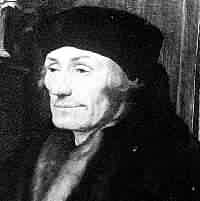
Erasmus of Rotterdam, a painting by Hans Holbein the Younger. 1523 AD.
BELGIUM
ROMAN BELGIUM
The region known as Belgium was originally occupied by a Celtic tribe known as the Belgae, as named by the Romans when they occupied the area. The Roman region of Gallia Belgica (Belgian Gaul) included what is now Belgium, northern France, the Netherlands, and part of Switzerland.
FRANKISH RULE
Belgium's territory was then overrun by the Germanic Franks following the collapse of Rome: by the 8th Century, it formed an integral part of Charlemagne's empire, as was the case with the entire Low Country region. The fortunes of Belgium then mirrored that of the Netherlands - the two regions were physically united - until 1839, when the Belgians managed to declare themselves independent of Dutch rule.
EXPANSION AND COLONIZATION
The newly independent Belgians lost no time in catching up with the other European countries. Under the Kings Leopold I and Leopold II, the country rapidly industrialized. King Leopold II personally took possession of a stretch of Africa known as the Congo. This private property of the king was later bequeathed to the Belgian state and became known as the Belgian Congo until the 1960s, when Black nationalists seized control of the country, committing some of the most bloody anti-White atrocities in Africa.
THE FIRST AND SECOND WORLD WARS
Belgium continued to expand and grow economically until the advent of the First World War. Invaded and held by the Germans for the largest part of that conflict, many great battles of the war were fought in Flanders. The country was devastated as a result, and the situation was only slightly improved when it was given a small piece of Germany by the Treaty of Versailles in 1919 as compensation.
No sooner had the country started to recover from the First World War but it was invaded by Germany again in 1940. The new occupation lasted until 1944, when Allied troops drove out the German forces.
FLEMINGS AND WALLOONS - REGIONAL GOVERNMENTS CREATED
Belgium once again recovered after the devastation of the war, recreating the pre-war growth levels within a decade. However, rivalry between the French speaking Walloons and the Dutch dialect speaking Flemish erupted into riots during the 1960s, and as a result separate Flemish and Walloon regional governments were set up in 1974, with further regional development being implemented in 1993.
IMMIGRATION
Immigration by Third World peoples has also occurred to a significant level in Belgium: these and other related developments are reviewed in a later chapter.
LUXEMBOURG
The history of the tiny country of Luxembourg mirrored that of the Netherlands and Belgium precisely until 1867, when, a Franco-Prussian crisis as provoked by a French attempt to buy the region of Luxembourg, resulted in an international treaty guaranteeing the country's independence. Luxembourg was occupied twice by Germany in both World Wars, suffering damage as a result, but the country has been stable and one of the most prosperous small nations of the world ever since, and enjoys one of the highest standards of living in Europe.
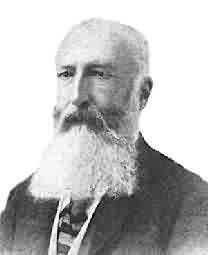
When one White man owned an entire country in Black Africa. Leopold II, King of Belgium, founded the African country now known as the Congo. This he did with the assistance of the great White British explorer, Sir Henry Stanley. Leopold's Congo state - virtually his private property - was formally recognized by the other White powers in 1885, and would remain a colony until the 1960s.
or back to
or
All material (c) copyright Ostara Publications, 1999.
Re-use for commercial purposes strictly forbidden.